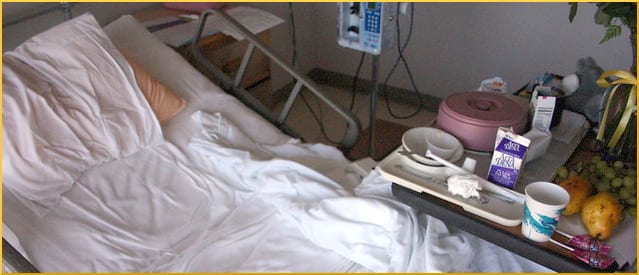
Smoking, drinking, and compulsive eating cause a lot of havoc in society. If people did not do those things, it would be better for everyone. Sometimes, we ask the government to step in and exert some muscle.
Going after certain businesses has often been a government concern. Zoning is a serious deterrent. A liquor store may not be too close to a school or a church, and neither may a lot of other things. A tobacco product billboard has to stand at least 1,000 feet from a playground.
Locations are judged to be more or less sensitive; the populations that are served (or targeted, depending on who’s talking) are deemed more or less vulnerable. Control is easiest to exert over institutions that depend on government funding, like hospitals.
Hospitals contain large numbers of the undeniably vulnerable. Patients are sick already, and don’t need any exacerbating factors to pile on. One historian says of the old days,
If you wanted to smoke in your hospital bed it was allowed. In fact, a lot of people resisted making hospitals non-smoking because of the challenge of getting sick people outside to enjoy a cigarette, which is kind of ironic.
An episode of the painstakingly accurate 1960s TV series Mad Men portrayed the Don Draper character in a hospital waiting room with a cigarette machine. Some people alive today might be amazed to know that Americans used to smoke in airports, college classrooms, doctors’ waiting rooms, just about everywhere.
An online nurses’ forum asked for reminiscences about the bad old days. One nurse recalled pharmacy carts fitted out with ashtrays, for nurses to use as they passed out meds. Another respondent contributes that in 1977, “everyone smoked in the hospital”:
I know they were still smoking in nursing station in early 80s, late 80s it became a no no. At first hospitals made special smoking areas on each floor, then smoking was limited to one special area in bldg like section of cafeteria., then came complete ban in early 90s.
Another recalls how, when the ban descended, staff members had to go outside for their tobacco breaks, while patients with their doctor’s permission could still smoke in certain indoor areas.
In the late 1980s and early 1990s, the Joint Commission on the Accreditation of Healthcare Organizations (JCAHO) was gunning for hospitals, and they knew it. By the mid-90s, 96 percent of hospitals in America were in compliance with JCAHO’s rules, and some were even more stringent. Clamping down on hospitals led to an encouraging victory, the first industry-wide ban of workplace smoking, and the idea soon caught on in other businesses.
All these illustrations pertain to the question of junk food in hospitals, available to visitors and staff, and potentially available to patients, against doctors’ orders. Can fast food outlets be excluded from hospitals? Should they be? Or maybe from children’s hospitals only?
The tobacco industry has taken a hit, and laws pertaining to alcohol may be very strict indeed. But even though the overconsumption of food can have tragic consequences, is it likely to ever face the same sanctions as cigarettes and liquor?
Your responses and feedback are welcome!
Source: “Remember when you could smoke anywhere and everywhere?,” ChathamDailyNews.ca, 02/13/13
Source: “Drinking with Draper,” SeattleMet.com, 09/14/09
Source: “Hospital Smoking Bans and Their Impact,” NIH.gov, February 2004
Source: “Trivia: When was smoking banned in all US hospitals,” AllNurses.com, 01/20/02
Photo credit: Kai Schreiber (Genista) on Visualhunt/CC BY-SA

 FAQs and Media Requests:
FAQs and Media Requests: 












One Response
Thanks for sharing such an amazing article, really informative !!
(http://www.seyyone.com/)